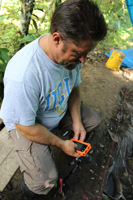Case Studies
“The LifeProof cases proved invaluable and frankly, I was amazed by them, especially in these field conditions.”
– Director of the Zooarchaeology Lab in the Cotsen Institute of Archaeology at the University of California, Los Angeles
When Shann Dornhecker first toured the Zooarchaeology Lab in the Cotsen Institute of Archaeology at the University of California, Los Angeles, it wasn’t just the piles of mysterious bones or carefully catalogued artifacts that stood out to her. The undergraduate student was struck by the tedious, manual method used to transfer hand-collected field data into an electronic format.
“The first thing I saw was this person unloading huge bags of samples and then reading the little slips of paper and entering them into an Excel sheet,” she said. “I was thinking ‘how can I make this easier?’ There’s got to be an app for this. But there was no app.”
This revelation sparked Dornhecker’s passion for innovation. She decided then and there to pursue her anthropology degree with an emphasis on archaeology through the Cotsen Institute with a goal of enhancing and simplifying the long-standing practices of a field that is archaic by design. Working with St. Louis-based software developer Skeleton Key, Dornhecker set out to “bring Indiana Jones into the 21st Century,” creating an app-based solution to enhance data collection in the field and lab.
It did take some convincing. Dornhecker’s independent research project is being advised by Dr. Tom Wake, director of the Zooarchaeology Lab, who has embraced many modern technologies in his work teaching students and conducting research. Computer advancements as well as 3D mapping and modeling have pushed the boundaries of the field of archeology. However, as evidence by the myriad shelves of field books in this lab, Wake relies on the traditional hand-written method of collecting and recording data in the field. Field conditions are not ideal for technology, but the manual data collection necessitates redundant data entry – taking up time, resources and opening up the door for error.
Dornhecker’s solution is Drago Data – named after the Panamanian jungles where it had its first trial. The FileMaker-based iOS app uses a barcode/QR code system, allowing bags of artifacts to be digitally tagged. An item’s description, exact location, location relative to other pieces and other important data points are recorded real-time in the dig site using handheld mobile technology. In addition to gathering the industry standard data, the technology allows for images to be quickly and easily attached to the record.
The system was tested during an annual archeological excursion to Boca Del Drago – a biologically diverse island region in Panama. Wake and his students have been exploring the area for more than 10 years. The crew sets up the site in one-meter square sections, and digs in 10-centimeter increments. Soil is collected in a mesh screen and then rinsed to uncover small beads, bones, ceramic fragments, etc. Between the extreme humidity of the climate and the nature of the work being done, technology typically does not fair well.
“I had a lot of concerns about the mobile technology because the conditions are pretty tough. In fact, I would call Boca Del Drago the place where computers go to die,” said Wake. “It can go from heavy rain to bright sun in just a few hours. It’s sandy and salty. If you drop something that has little ports open on it and you can get mud or sand or dust or leaves or all of that at the same time into the ports or openings of a computer, cell phone or camera.”
Dornhecker was prepared for this, though. She had the Apple iPod Touch devices outfitted with LifeProof frē cases. LifeProof frē offers protection from dirt, water, drops, mud and sand – the environmental hazards of fieldwork.
“Without the LifeProof cases, the second that some mud or water got on the unit that’s it, you’re done,” Dornhecker said, adding that device functionality is just as important as protection in the field. LifeProof frē is designed to allow full use of the device features and functions, including the camera, touch screen and, on newer Apple devices, Touch Id.
“The LifeProof cases proved invaluable and frankly, I was amazed by them, especially in these field conditions,” said Wake. “People would drop the cases in mud or sand and since they were sealed, there were no issues about grit and dust and mud and the moisture didn’t penetrate at all. One of the things that impressed me is that we had the iPod touches in the LifeProof frē cases at the screening table which is where we’re spraying all the dirt with water making mud and splashing and there’s mud and occasionally the units would get dropped into the mud or stepped on and we could just pick them up, wash them off and then pick up something, scan the tags and enter the data without any problem at all which was pretty amazing to me.”
Dornhecker views Drago Data is a multifaceted solution. Her hope is that by eliminating inefficiencies, archeologist will have extra time in the field for discovery - important in an industry largely dependent on grants. Additionally, it promises to offer a more holistic set of data that is free from accidental entry errors. Drago Data seeks to push the field of archeology beyond its current boundaries, and LifeProof is there to take mobile technology where it hasn’t been before.
